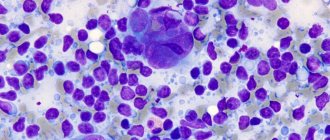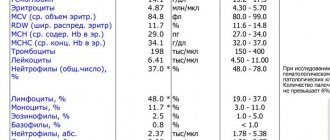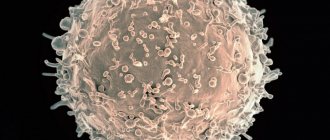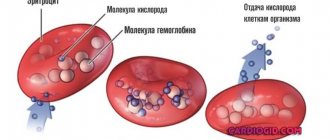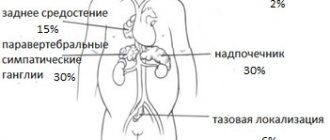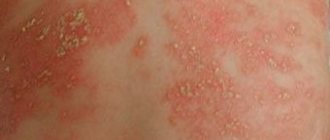0
Author of the article: Marina Dmitrievna
2017.08.21
13 408
Blood analysis
When a foreign agent enters the human body, the immune system launches a defense mechanism. The concentration of specific cells in the blood increases, which are sent to destroy pathogenic microorganisms. If a child has elevated lymphocytes and monocytes, what does this mean?
Functions of blood cells
Monocytes are white blood cells that are found in the blood and then move into tissues where they transform into mature cells. They are sent to places where pathogenic microorganisms actively multiply.
An increase in the number of monocytes indicates that a foreign agent has entered the body. When it penetrates, the immune system rapidly produces cells to destroy the irritant.
Lymphocytes are responsible for ensuring that the immune response starts and stops on time. They identify bacteria and eliminate them, produce immunoglobulins, and remember information about a foreign substance.
Monocytes and lymphocytes are important for the normal functioning of the body. Deviations in their content indicate the presence of pathologies, which helps with diagnosis.
Monocytes and lymphocytes
General information
Monocytes in the blood are representatives of a young group of cells; they are sent to tissues, from where monocytes emerge as mature histiocytes and macrophages. In addition, they migrate to the mucous membranes and skin, where they first meet agents of foreign origin.
Thus, macrophages and histiocytes perform phagocytosis of the pathogen. When monocytes become elevated, this is a sign of the presence of an agent of foreign origin in the tissues; accordingly, the monocyte level increases, since there is an increased need for macrophages. During their delivery to the tissues, the amount in the blood also increases, which is demonstrated in tests along with an increase in leukocytes and changes in other blood parameters.
Another important indicator that is often considered together with monocytes is lymphocytes. In the body, different functions lie on the “shoulders” of these cells:
Norm of ESR in children 2723
- What does it mean to have a decrease in neutrophils and an increase in lymphocytes in the human body?
- the process of starting and stopping the immune response;
- recognition of proteins of foreign origin;
- production of immunoglobulins;
- destruction of the pathogen cell;
- storing information about it and recording it in the genetic code.
Thus, lymphocytes perform immunity work in two directions. These are cellular and humoral immunity. Very often, the analysis does not use 100 percent of only one cell. For example, if neutrophils are low, this does not make it possible to make a diagnosis directly. It is important to consider high and low indicators together, and not separately. That is why it is often important for doctors to see the combination of monocyte and lymphocyte levels.
Against the backdrop of an integrated approach to deciphering the analysis, you can understand what stage the pathological process is at, make a prognosis for the development of the disease, understand its causes, confirm the diagnosis and understand how impaired the immune system is.
Norm of lymphocytes in the blood
Important!!! In children under one year of age, elevated lymphocytes are not considered a pathological condition. The high rate is observed due to the fact that young children have an immature immune system. It develops over several years, so the level of lymphocytes decreases gradually with age.
In the first days of life, the indicator does not exceed 25%, at the end of the first year it increases and for 4 years remains at a high level - 50-65%. Then the level decreases. By 6 years it is 42%, after 10 years - 40%, by 18 years the norm is established - 37% and does not change in healthy people.
As for monocytes, they change as the child grows:
- The first hours of life - 10%.
- From 5 days to 1 month - 14%.
- 1 month - 12%.
- From one year to 5 years - 10%.
- From 5 to 15 years 4-6%.
- Over 15 years old - 7%.
If the level is elevated, the condition is called monocytosis.
A general blood test in pediatrics is a mirror of a child’s health.
Timely and effective treatment of any disease always depends on a correct diagnosis. Any adult, visiting a pediatrician with their child about an illness, wants his child to recover as quickly as possible. On the other hand, it is very important for the attending physician, in addition to complaints, medical history and the objective condition of a small patient, to have data from laboratory and instrumental examinations when making a diagnosis. The most universal of them are general clinical blood and urine tests. Their value lies not only in the speed and ease of implementation, but also in the highly informative content of the results. A general blood test is always taken on an empty stomach (except in emergency cases), i.e. Before coming for the procedure, you must avoid taking any food and limit your fluid intake. Therefore, blood is taken for analysis in the morning so that the child does not have to starve for a long time. The material for analysis is blood taken from a finger or vein. The importance of this rule is due to the fact that after eating, some indicators (the level of white blood cells - leukocytes, ESR) may deviate from the norm, thereby creating a false picture of the disease. If possible, you need to prevent stress when taking blood from a child over 2 years old by talking with him the day before about the upcoming examination, encouraging him after the procedure, etc. Now for you, dear Parents, a little information about the most frequently determined indicators included in the general blood test form.
Hemoglobin is a substance that is part of red blood cells and acts as a carrier of oxygen and carbon dioxide, consists of protein and iron. Normal hemoglobin levels: – newborns – 160-230 g/l; – children under one year old – 110-130 g/l; – from one to 4 years – 110-140 g/l; – from 4 to 7 years – 110-146 g/l; – from 7 years and older – 110-152 g/l. An increase in hemoglobin levels is observed during high physical activity, excitement, stressful situations, dehydration (vomiting, diarrhea), burns and some blood diseases. A decrease in hemoglobin levels is typical for anemia of various origins, degenerative processes, and may be a side effect of certain medications.
Hematocrit is an indicator indicating what part of the blood volume is occupied by formed elements (cells). The norm for newborns is 40-60%, for children from 2 months to 4 years 30-41%, from 4 years and older 34-43%. An increase in the hematocrit level is observed with blood thickening associated with dehydration or diseases that increase the number of cells (erythremia, leukemia). A decrease in this indicator occurs with anemia.
Erythrocytes are red blood cells that contain hemoglobin. Responsible for the transport of oxygen, carbon dioxide, amino acids, antibodies, drugs and toxins. The lifespan of these cells is 120 days. Normal indicators for children: – from birth to 2 months. — 3.9-6.2 T/l; – from 2 to 4 months. — 3.1-4.5 T/l; – from 4 months to 4 years – 3.0-5.4 T/l; – from 5 years and older – 3.5-5.0 T/l. An increase in the level of red blood cells is characteristic of oxygen starvation, chronic lung diseases, congenital heart defects, some blood diseases and neoplasms. A low level of red blood cells is observed with anemia, infections, helminthic infestations, bleeding, obesity, due to increased background radiation. The cause and form of anemia can be determined by the average volume of red blood cells. For children aged 4 months to 4 years, the norm is 75-115 fL, from 5 to 7 years 76-108 fL, from 8 years and older -76-96 fL. An increase in this indicator is observed in anemia associated with deficiency of vitamin B12, folic acid, liver diseases, dysfunction of the bone marrow and thyroid gland, and after bleeding. A decrease in the indicator is characteristic of iron deficiency anemia; hyperfunction of the thyroid gland; anemia associated with chronic diseases; congenital anemias.
Leukocytes are white blood cells whose main function is to protect the body from foreign influences. Leukocytes participate in inflammatory, allergic, and immune reactions, destroying cell breakdown products, viruses and bacteria. Normal indicators: – for newborns – 13-20 G/l; – for children from 1 week to 1 month – 5-20 G/l; – for children from 1 month to 1 year – 6-15 G/l; – from 1 year to 6 years – 5-14 G/l; – from 6 years and older – 6-11 G/l. An increase in the level of white blood cells (leukocytosis) is observed after acute bleeding; for neoplasms; blood diseases; for most infectious diseases of a bacterial nature (both acute and chronic). Short-term physiological leukocytosis is provoked by food intake, pain, emotional stress, physical effort, and exposure to ultraviolet radiation. A decrease in the level of leukocytes (leukopenia) is observed in infections such as influenza, ARVI, measles, psittacosis, viral hepatitis and malaria. Long-term bacterial infections, depleting the body, also reduce the level of leukocytes. Dangerous causes of leukopenia are blood diseases, autoimmune diseases, and the consequences of exposure to radiation.
The leukocyte formula includes a group of cells of different structure and function (neutrophils, eosinophils, basophils, monocytes, lymphocytes), the quantitative determination of which provides a lot of valuable diagnostic information.
Neutrophils are the most numerous type of leukocytes. According to the degree of maturity, young, band and segmented neutrophils are distinguished. The main function of these cells is protective. Normally, the majority of neutrophils should be represented by segmented cells. The appearance of young forms and a large number of band neutrophils in the child’s blood most often indicates an acute inflammatory process. The normal content of neutrophils in the blood of a child from 4 months to 4 years is 30 - 55%, at the age of 5-7 years - 40 - 60%, 8 - 14 years - 45 - 70%. An increased number of neutrophils is observed during inflammatory processes, after surgical interventions, against the background of bacterial, fungal and some viral infections, parasitic infestations, during intoxication, blood diseases, and neoplasms. A low level of neutrophils is characteristic of anemia, acute viral and chronic infections.
Eosinophils are cells that indicate allergic reactions in the body. In children at any age, the norm is from 1 to 5%. An increase in the rate is observed in allergic diseases: bronchial asthma, urticaria, Quincke's edema, hay fever, hypersensitivity to drugs, a number of skin diseases, scarlet fever, helminthic infestations, and some neoplasms.
Basophils are participants in allergic and inflammatory reactions. Normally, the number of basophils ranges from 0 to 5% of the total number of leukocytes. Of clinical significance is the increase in the number of basophils, which is observed in allergic reactions, leukemia, lymphogranulomatosis, and decreased thyroid function. Lymphocytes are the most active cells of the immune system, taking part in all types of its activities. The level of lymphocytes changes significantly throughout a child's life: in children under 5 years of age, the number of lymphocytes normally exceeds the number of neutrophils, and after 5 years the situation changes to the exact opposite. If at the age of up to 5 years the norm is 45 - 65% of lymphocytes, then by 7 years the normal figure decreases to 30 - 55%, and then at 8 years and older to 20 - 40%. An increased number of lymphocytes in the blood is observed in most viral infections: viral hepatitis, infectious mononucleosis, whooping cough, rubella, cytomegalovirus, herpes, as well as tumor diseases. A decrease in the level of lymphocytes is characteristic of bacterial diseases, tuberculosis, systemic lupus erythematosus, renal failure, bone marrow dysfunction, and immunodeficiency conditions.
Monocytes are also immune response cells. The norm for children of any age is up to 8%. An increase in the rate is observed in viral and fungal infections, septic endocarditis, during recovery from infectious diseases, tuberculosis, neoplasms, and rheumatoid arthritis. A low level of monocytes is characteristic of leukemia, severe forms of anemia, and exhaustion of the body.
Erythrocyte sedimentation rate (ESR). The value of this indicator depends on the viscosity of the blood, the presence of normal and pathological proteins in it, and the number of cellular elements. By itself, the ESR value does not mean anything, however, in combination with other changes in the general blood test and the condition of the child, the indicator can provide very useful and necessary information. For children, the normal level of ESR is considered to be 2-10 mm/h (in newborns 1-2 mm/h, in children under 6 years old the rate can be increased to 15 mm/h). An increase in ESR is observed during infections, inflammatory diseases, anemia, tumors, and while taking certain medications. A decrease in ESR is characteristic of some types of anemia and blood diseases.
Platelets are blood platelets. The main function of platelets is to clot blood and stop bleeding. Normal values for children under 7 years of age are 150 - 400 G/l, 8 - 14 years old - 150 - 380 G/l. An increase in platelet levels is observed in cases of blood cancer, tuberculosis, rheumatoid arthritis, anemia, after surgery or physical activity. A decrease in the rate is typical for viral and bacterial infections, chronic bleeding, liver and kidney diseases, severe anemia, diseases of the immune system, tumors, congenital heart defects, and impaired thyroid function.
Dear parents, I would like to draw your attention: the limits of normal blood counts may vary depending on the laboratory that conducted the study. Therefore, always compare the results obtained with the reference values indicated in the analysis form!
The results of a general blood test can only be interpreted in conjunction with all available medical information: taking into account complaints, medical and life history, examination data, and the results of other laboratory and instrumental examinations.
Only an experienced doctor can understand such a volume of information, so be sure to discuss the results of your child’s general blood test with your pediatrician.
Be healthy!
Simultaneous cell enhancement
Monocytes and lymphocytes are two types of white blood cells that determine the functioning of the immune system. If their level increases, this indicates that the immune system is fighting pathogenic microflora in an enhanced manner. The child’s defense mechanism works properly and clearly reacts to foreign agents.
When the level of lymphocytes and monocytes is increased in a child during the period of recovery from an infectious pathology, the disease has receded. This deviation from the norm is positive. It is also observed after surgery.
If two indicators increase during a viral pathology, then a bacterial infection may occur. The doctor checks the injection sites, examines the child’s body looking for redness, diaper rash, and purulent processes in the throat.
Low levels of indicators are observed in some diseases. Lymphocytes are reduced and monocytes are increased during inflammatory processes in the body. In this case, the doctor takes into account other research indicators, complaints and symptoms of the disease.
A child has a cold
What are monocytes in the blood
Monocytes are a type of leukocyte - white blood cells. These are large formations with large nuclei. They are involved in protecting the body from inflammatory processes. Monocytes can penetrate the walls of blood vessels, leaving the blood and rushing to the site of inflammation. They destroy bacteria, viruses, as well as dead cells of their own body. It turns out that monocytes perform an important sanitary function.
This is especially important during infectious diseases. For example, if a person is sick with the flu, at this moment many cells of the oropharynx and nasal cavity are destroyed. Then monocytes will arrive in large numbers to the appropriate areas and digest the dead parts of the cells. In this case, the tissues will recover faster, which will contribute to overall recovery.
Why do monocytes increase?
Monocytes in a child’s blood are slightly elevated if a purulent infection develops or if he is recovering from a cold. This occurs when the baby is teething or when he bumps or gets injured. A slight increase occurs as a hereditary factor.
If the deviation is pronounced, then this indicates the development of pathology. Indeed, in case of illness, the baby’s circulatory system is not able to fight a huge number of harmful microorganisms, so the bone marrow produces a large number of leukocytes.
An increased rate of monocytes is observed in the following conditions:
- Autoimmune disorders. They cause active production of leukocytes, monocytes, neutrophils to ensure stable functioning of the immune system.
- Infectious mononucleosis. It has a negative effect on the tonsils, liver, lymph nodes and spleen, and therefore affects the composition of the blood.
- Malaria. Accompanied by an increased level of monocytes, the level of hemoglobin and red blood cells decreases.
- Leukemia. Monocytes are increased in the monoblastic type of pathology, but this is rare.
- Polycythemia. It affects the bone marrow, so it does not adequately produce all blood cells.
- Parasites. When parasites enter a child’s body, the immune system produces many white blood cells to fight them.
- Congenital syphilis. Transmitted in utero from a sick mother. The pathology causes leukocytosis, but erythropenia is observed.
- Intoxication of the body with chemicals.
Diseases of the digestive organs, fungal infection, endocarditis, sepsis, and surgical treatment can also provoke an increase in the number of monocytes.
Leukemia in a baby causes an increase in monocytes
Causes of increased lymphocytes
There is an age-related increase in lymphocytes in the blood of a newborn child, which is due to the fact that the baby’s immune system is just beginning to develop and does not function fully. In this case, no therapy is required. Over time, the indicator will recover on its own. If the content of these cells is higher than the norm that corresponds to a particular age, then there must be a reason for this.
Doctors divide lymphocytosis into malignant and reactive. The first assumes that the concentration of cells increases due to cancer. The second type of pathology is a reaction to the influence of foreign substances and microorganisms that penetrate the internal organs of a person.
The malignant type of lymphocytosis is rarely diagnosed. But it occurs at any age, even in a one-year-old child. But the diagnosis is not made by one blood test. To detect oncology, additional diagnostics are prescribed.
With a malignant increase in cells, a person feels weak, anemia develops, the skin becomes pale, the nose often bleeds, the lymph nodes become enlarged, the temperature rises, pain in the affected area is tormented, and the body is more easily susceptible to infectious pathologies.
Most often, lymphocytes are elevated in children when acute lymphoblastic leukemia develops in the body. This disease causes difficulties in treatment, but if it is detected at the first stage, then there is a chance to eliminate the disease.
All described pathologies are rare. Basically, an increased level of lymphocytes in children indicates that the child has an infectious disease or has recently suffered from it. Such pathologies include:
- Viral: colds, chicken pox, rubella, herpes, hepatitis.
- Bacterial: tuberculosis, brucellosis, syphilis.
- Parasitic: helminthic infestations.
There are factors that can provoke an increase in lymphocytes in the blood of babies:
- Disturbances in the activity of the endocrine system.
- Failure of hormonal balance in the body.
- Autoimmune pathologies.
- Spleen removal surgery.
- Intoxication of the body with heavy metals and chemicals.
- Treatment with certain medications, for example: antibiotics, painkillers, hormonal agents.
- Vitamin deficiency in the body.
- Vaccination.
- Frequent stressful situations.
- Getting injured.
Lymphocytes in children may be elevated due to intense physical activity.
Important!!! The exact cause should be determined by the attending physician. There is no need to make a diagnosis yourself and prescribe treatment for your child. A blood test is an indicator that there are disorders in the body, but cannot indicate the exact cause. To do this, you will need to undergo additional examination.
Decreased cell level
Monocytes and lymphocytes can rise and fall. This deviation also indicates the presence of pathologies in the body or the influence of physiological factors.
As for monocytic cells, their level will decrease in the following cases:
- If bacteria have entered the body and caused the development of severe infectious diseases or sepsis.
- If there are helminthic infestations in the digestive organs. To destroy them, many monocytes are produced, but most die in the process of fighting parasites.
- If a malignant neoplasm develops. In this case, the bone marrow is often affected, which then loses the ability to produce cells. As a result, lymphocytes, monocytes and neutrophils are reduced.
Lymphocytes decrease due to infectious, colds, and inflammatory diseases. Doctors identify provoking pathological conditions: AIDS, hepatitis, tuberculosis, pneumonia, sepsis, lupus, rheumatism, kidney failure, influenza, mononucleosis.
In addition to diseases, a reduced concentration of lymphocytes in a child’s blood is caused by radiation or chemical therapy, or taking certain medications.
Penetration of bacteria
Causes of monocytosis and lymphocytosis: what provokes deviations from the norm?
If we consider each formed element separately, then their increase can be caused by a variety of factors. When the number of monocytic cells increases, they speak of monocytosis. And when the level of lymphocyte bodies increases, the condition is called lymphocytosis.
Reasons for the development of monocytosis
- Acute infectious diseases or exacerbations of chronic inflammation (tuberculosis, influenza, endocarditis, candidiasis, syphilis);
- Autoimmune disorders (sarcoidosis, rheumatoid arthritis);
- Malignant neoplasms;
- Poisoning with toxic drugs, phosphorus;
- Oncological diseases of hematopoiesis (myeloid leukemia, lymphogranulomatosis);
- Appendicitis, sepsis.
The degree of increase in parameters indicates the severity of the immune system’s response to the development of the disease. The stronger the inflammation, the more macrophages are required for phagocytosis of foreign bodies.
- Increased level of lymphocytes in the blood
Reasons for the development of lymphocytosis
- Viral infection (mononucleosis, hepatitis, measles);
- Chronic lymphocytic leukemia;
- Poisoning of the body with chemicals (arsenic, lead);
- Taking medications (Levopod, Phenytoin, narcotic painkillers);
- Toxoplasmosis, leptospirosis;
- Crohn's disease;
- Endocrine diseases.
Increased lymphocyte levels are associated with a significant response to antigenic stimulation. They become larger than normal when a viral/bacterial infection occurs, as well as when cancer cells develop in the body.
How to restore blood cell levels?
In itself, an increase in lymphocytes and monocytes in a child or an adult is not a pathological condition. There are no medications that could bring them back to normal. The indicator can be restored if the cause that caused the deviation is eliminated. As soon as the provoking factor disappears, the cell level normalizes on its own.
Therefore, if the blood cell count is low or high, doctors prescribe additional diagnostics, the purpose of which is to identify the cause of the increase in the number of cells. Based on the examination results, the doctor will make a diagnosis and prescribe appropriate treatment.
